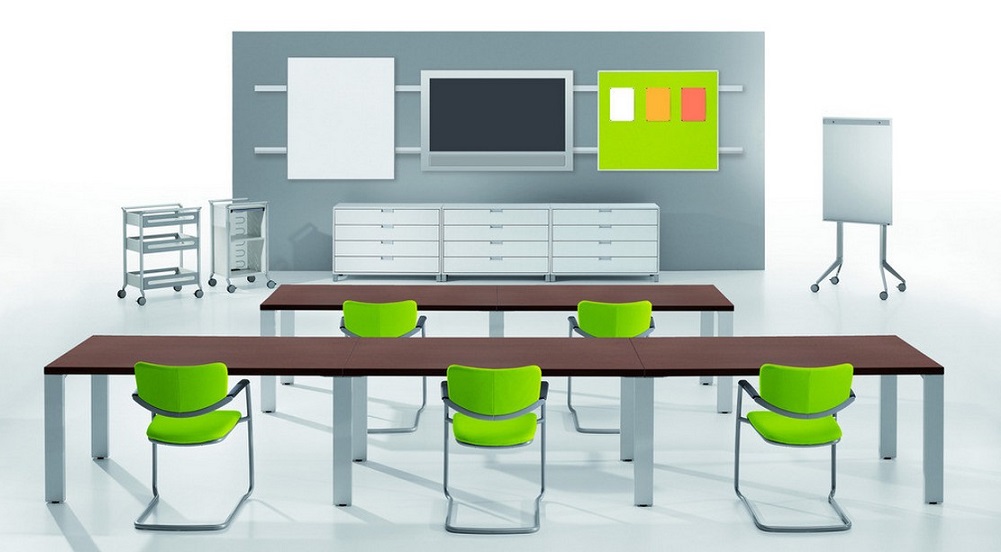Classrooms
 In our time, the technological development of mankind has become more rapid than ever. We can constantly observe the emergence of new multimedia solutions for home use, improving the efficiency of business, production and many other areas of human activity. Education has not bypassed progress either.
In our time, the technological development of mankind has become more rapid than ever. We can constantly observe the emergence of new multimedia solutions for home use, improving the efficiency of business, production and many other areas of human activity. Education has not bypassed progress either.
Modern educational institutions face a difficult task: they need not only to provide themselves with qualified personnel, but also to keep up with the times, introducing technologies that make the learning process more effective and exciting.
It is difficult to overestimate the importance of modern multimedia technologies in education. Their use expands the capabilities of the teacher, helps him to reveal the potential of students, facilitate the presentation of information and visualize it better. A well-designed system of interactive equipment makes modern classrooms self-sufficient premises for conducting all types of classes. With it, the teacher can demonstrate images and videos, play audio recordings, show presentations, conduct surveys and voting, save information from the blackboard to a computer or smartphone, print it out and even store a history of changes!
Interactive learning is the key to the involvement of all students. The opportunity not only to take notes, but also to work with multimedia materials of lectures, make notes, interact with the entire audience, gives students an additional incentive to delve into the essence of the subject.
The equipment of the classroom, as a rule, includes an interactive blackboard, which is used not only for manually applying text information to it, but also for demonstrating colorful multimedia content in high resolution. Moreover, such boards allow you to interact with the content in real time, making notes, making edits or additions.
In addition to the blackboard, multimedia classrooms are equipped with audio-visual systems designed to demonstrate presentations, audio and video recordings, facilitating the perception of new information by students. Such tools include LCD displays, a speaker system and document cameras. The latter are devices that display a large image of an object on a common screen. This allows you not to waste time on demonstrating the object to each student individually. With their help, you can both show documents on paper and display an object in detail, drawing the attention of the entire audience to its important features.
The projector for the classroom is always used in conjunction with a reflective screen, which is specially designed to correctly display information from the projector. Mobile equipment is suitable for classes during which it is necessary to move the screen or adjust the viewing angle. In addition, it makes sense to use an electronic flipchart, on which you can demonstrate information to a small audience and then save it on USB media.
Also, the educational multimedia audience will become much more functional with the presence of a polling and voting system. Such a system is an important element of the organization of effective work in any educational institution. It allows you to do instant surveys of the audience and find out their opinion on any issue. Voting systems do not require any special knowledge to work, and their management is always intuitive. In addition, many systems allow you to keep electronic records of opinions and compile tables and graphs of survey results.
In order to get the maximum result from the introduction of audio-visual equipment into the educational process, the design of the classroom should be thought out taking into account all the requirements of the teacher and the specifics of the subjects. For example, for some subjects, classrooms can be equipped with systems for working on the BYOD principle (Bring Your Own Device). This concept implies that each student uses their own electronic devices in the classroom, such as a laptop, tablet or smartphone. With their help, he can participate in joint work on the material and demonstrate the results by connecting to public screens. This approach allows students to immediately apply knowledge in practice and reduces the time between submitting the material and checking the first results.
It is also important that multimedia equipment of classrooms be installed with the possibility of quick replacement. Connectors and cables should be available to the teacher when necessary. This is an extremely important aspect of design, without which the learning process can be paralyzed even due to minor malfunctions.

Do not forget about the lighting. The requirements for the classroom in terms of illumination are quite strict and this is especially noticeable when designing multimedia learning systems.
Any classroom must necessarily have natural lighting. And artificial lighting should be left-sided and designed so that the main luminous flux does not fall from behind or in front of the student. These requirements should also be taken into account when organizing a multimedia system in the audience, otherwise the demonstration of materials may be difficult due to glare on the interactive screen or too faded image.
Using an interactive blackboard, an audio system, an electronic flipchart and a document camera, an initiative teacher can organize a colorful, informative, useful and exciting lesson that students will remember for a long time.
There are no products to list in this category.
